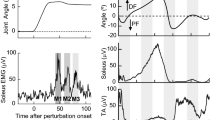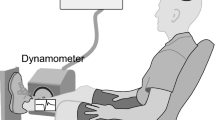Abstract
The modulation of the short latency stretch reflex of the soleus muscle during walking was investigated in seven spastic multiple sclerosis (MS) patients and nine healthy control subjects. Ankle joint stretches were applied by a system which can rotate that ankle joint in any phase of the step cycle during treadmill walking. The torque related to the muscle fibres contracting prior to the stretch and the passive tissues around the ankle joint were measured as the “non-reflex torque”. At the same time the short latency stretch reflex-mediated EMG response was measured. The findings show that the stretch reflex modulation was impaired in spastic patients during walking. The stretch reflex modulation was quantified by a modulation index of on average 50% (range −5 to 100%) in the patients and 93% (78–100%) in the control subjects (P < 0.05). The passive stiffness of the ankle joint was at the same time increased in the patients (P < 0.05). It is proposed that the impaired modulation of the stretch reflex along with increased ankle joint stiffness contribute to the impaired walking ability in spastic MS patients.
Similar content being viewed by others
References
Andersen JB, Sinkjær T (1995) An actuator system for investigating electrophysiological and biomechanical features around the human ankle joint during gait. Trans Rehabil 3:299–306
Akazawa K, Aldridge JW, Steeves JD, Stein RB (1982) Modulation of stretch reflexes during locomotion in the mesencephalic cat. J Physiol (hand) 329:553–567
Ashby P, Wiens M (1989) Reciporcal inhibition following lesions of the spinal cord in man. J Physiol (hand) 414:145–157
Baldissera F, Hultborn H, Illert M (1981) Integration in spinal neuronal systems. Handbook of physiology - the nervous system II, chapter 12. American Physiological Society, Bethesda, USA, pp 509–595
Berardelli A, Sabra AF, Hallett M, Berenberg W, Simon SR (1983) Stretch reflexes of triceps surae in patients with upper motor neuron syndromes. J Neurol Neurosurg Psychiatry 46:54–60
Berger W, Dietz V, Quintem J (1984) Corrective reactions to stumbling in man: neuronal co-ordination of bilateral leg muscle activity during gait. J Physiol (hand) 357:109–125
Berger W, Horstmann G, Dietz V (1984) Tension development and muscle activation in the leg during gait in spastic hemiparesis: independence of muscle hypertonia and exaggerated stretch reflexes. J Neurol Neurosurg Psychiatry 47:1029–1033
Dietz V (1987) Role of peripheral afferents and spinal reflexes in normal and impaired human locomotion. Rev Neuro (Paris) 4:241–254
Dietz V, Berger W (1983) Normal and impaired regulation of muscle stiffness in gait: a new hypothesis about muscle hypertonia. Exp Neurol 79:680–687
Dietz V, Quintern J, Berger W (1981) Electrophysiological studies of gait in spasticity and rigidity. Brain 104:431–449
Dietz V, Trippel M, Berger W (1991) Reflex activity and muscle tone during elbow movements in patients with spastic paresis. Ann Neurol 30:767–779
12.Fung J, Barbeau H (1994) Effects of conditioning cutaneomuscular stimulation on the soleus H-reflex in normal and spastic paretic subjects during walking and standing. J Neurophysiol 72:2090–2104
Hagbart KE, Wallin BG, Löfstedt L (1973) Muscle spindle response to stretch in normal and spastic subjects. J Rehabil Med 5:156–159
Hufschmidt A, Mauritz K-H (1985) Chronic transformation of muscle in spasticity: a peripheral contribution to increase tone. J Neurol Neurosurg Psychiatry 48:676–685
Lee RG, Tatton WG (1982) Long latency reflexes to impose displacements of the human wrist: dependence on duration of movement. Exp Brain Res 45:207–216
Matthews PBC (1991) The human stretch reflex and the motor cortex. Trends Neurosci 14:87–91
Morin C, Pierrot-Deseilligny E (1988) Mécanisme spinal de l'action antispastique de la TRH chez les malades atteints de sclérose latérale amyotrophique. Rev Neurol (Paris) 144:701–703
Nielsen J, Crone C, Petersen N, Sinkjær T, Toft E, Hultborn H (1995) Central control of reciprocal inhibiton during fictive dorsiflexion in man. Exp Brain Res 104:99–106
Poser CM, Paty DW, Scheinberg L, et al (1983) New diagnosis criteria for multiple sclerosis: guidelines for research protocols. Ann Neurol 13:227–231
Sinkjær T, Magnussen I (1994) Passive, intrinsic and reflex-mediated stiffness in the ankle-extensors of hemiparetic patients. Brain 117:355–363
Sinkjær T, Toft E, Andreassen S, Hornemann BC (1988) Muscle stiffness in human ankle dorsiflexors: intrinsic and reflex components. J Neurophysiol 60:1110–1121
Sinkjær T, Toft E, Larsen K, Andreassen S, Hansen HJ (1993) Non-reflex and reflex mediated ankle joint stiffness in multiple sclerosis patients with spasticity. Muscle Nerve 16:69–76
Sinkjær T, Andersen JB, Larsen B (in press) Soleus stretch reflex modulation during gait in normal man. J Neurophysiol
Sinkjær T, Nielsen J, Toft E (1995) Mechanical and electromyographic analysis of reciprocal inhibition at the human ankle joint, J Neurophysiol 74:849–855
Sinkjær T, Toft E, Hansen HJ (1995) H-reflex modulation during gait in multiple sclerosis patients with spasticity. Acta Neurol Scand 91:239–246
Toft E, Sinkjær T, Larsen K, Hansen H-J (1991) Mechanical and electromyographic responses to stretch of the human ankle extensors. J Neurophysiol 65:1402–1410
Toft E, Sinkjær T, Andreassen S, Hansen HJ (1993) Stretch responses to ankle rotation in multiple sclerosis patients with spasticity. Electroencephalog Clin Neurophysiol 89:311–318
Vallbo AB, Hagbarth KE, Torebjörk HE, Wallin BG (1979) Somatosensory Propriceptive activity in human peripheral nerves. Physiol Rev 59:919–957
Wainberg M, Barbeau H, Gauthier S (1986) Quantitative assessment of the effect of cyproheptadine on spastic paretic gait: a preliminary study. J Neurol 233:311–314
Yang JF, Stein RB, James KB (1991) Contribution of peripheral afferents to the activation of the soleus muscle during walking in humans. Exp Brain Res 87:679–687
Yang JF, Fung J, Edamura M, Blunt R, Stein RB, Barbeau H (1991b) H-reflex modulation during walking in spastic paretic subjects. Can J Neurol Sci 18:443–452
Author information
Authors and Affiliations
Corresponding author
Rights and permissions
About this article
Cite this article
Sinkjær, T., Andersen, J.B., Nielsen, J.F. et al. Impaired stretch reflex and joint torque modulation during spastic gait in multiple sclerosis patients. J Neurol 243, 566–574 (1996). https://doi.org/10.1007/BF00900943
Received:
Revised:
Accepted:
Issue Date:
DOI: https://doi.org/10.1007/BF00900943




